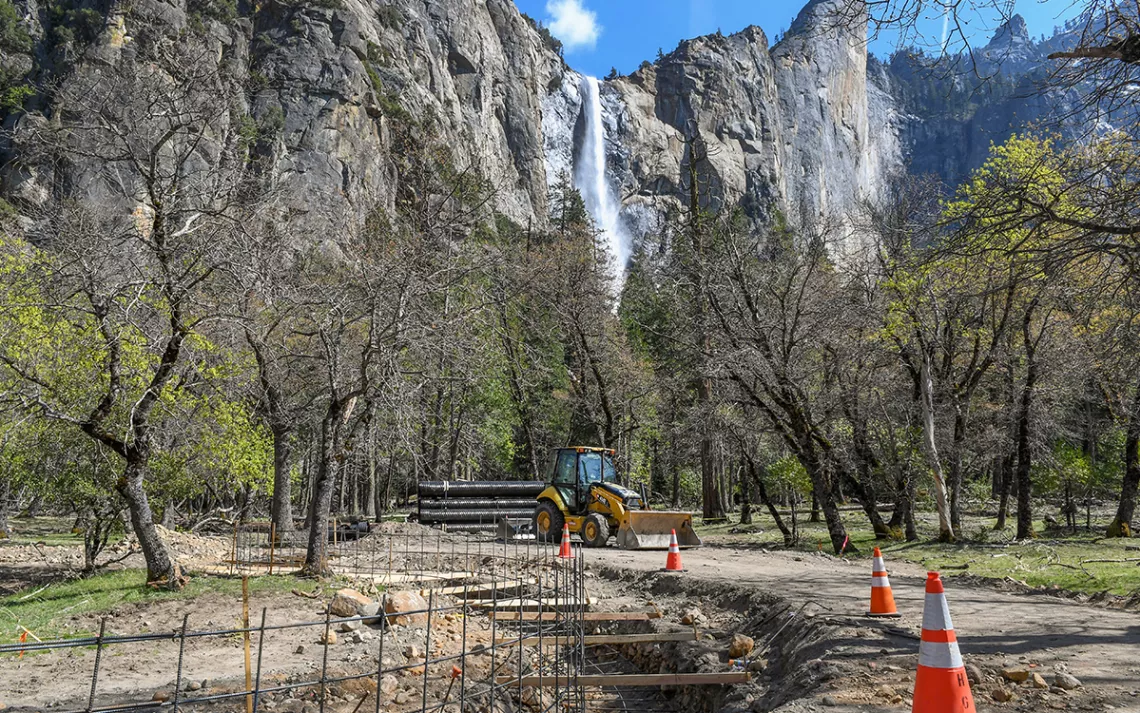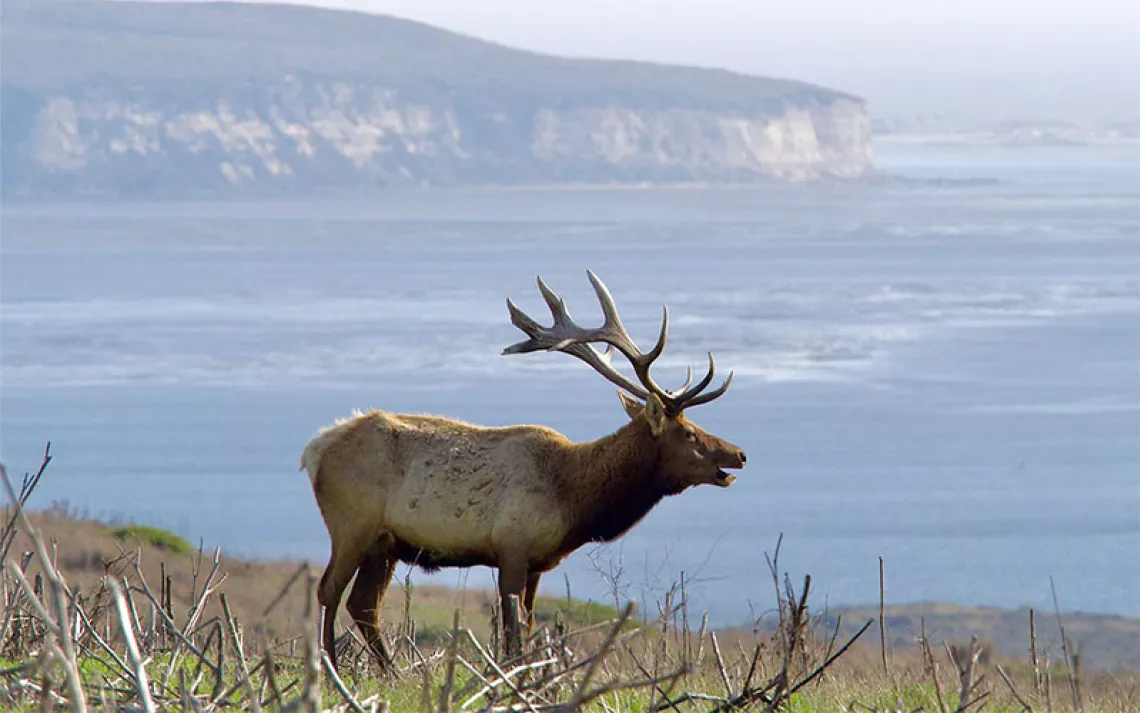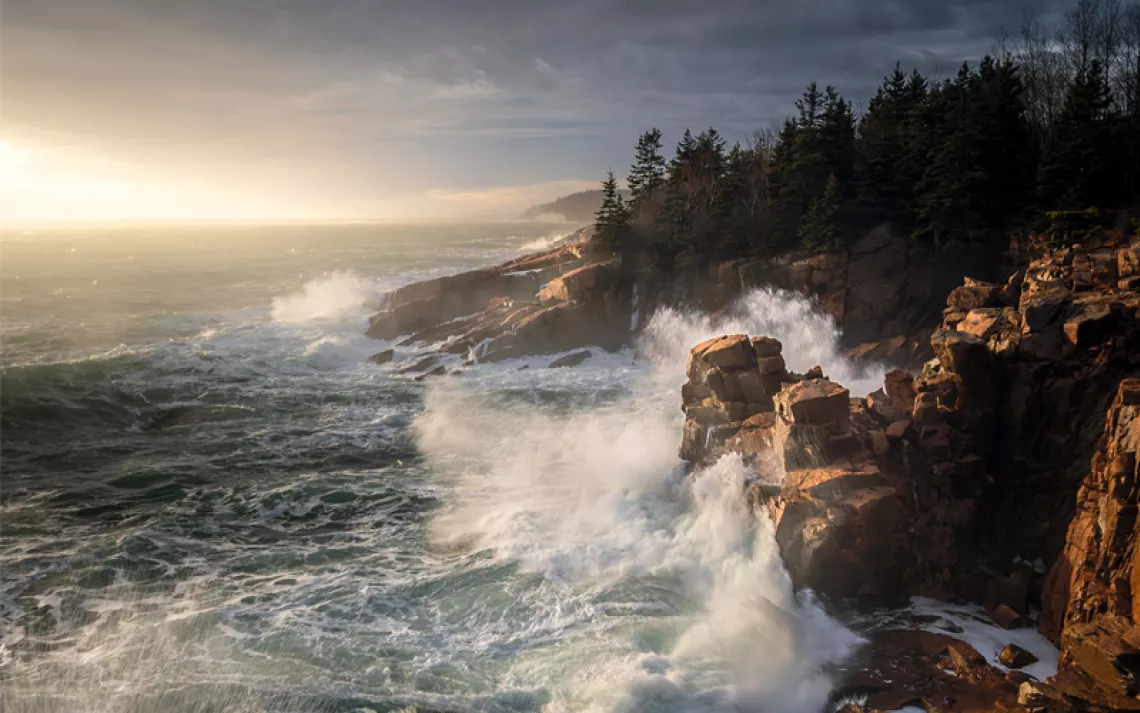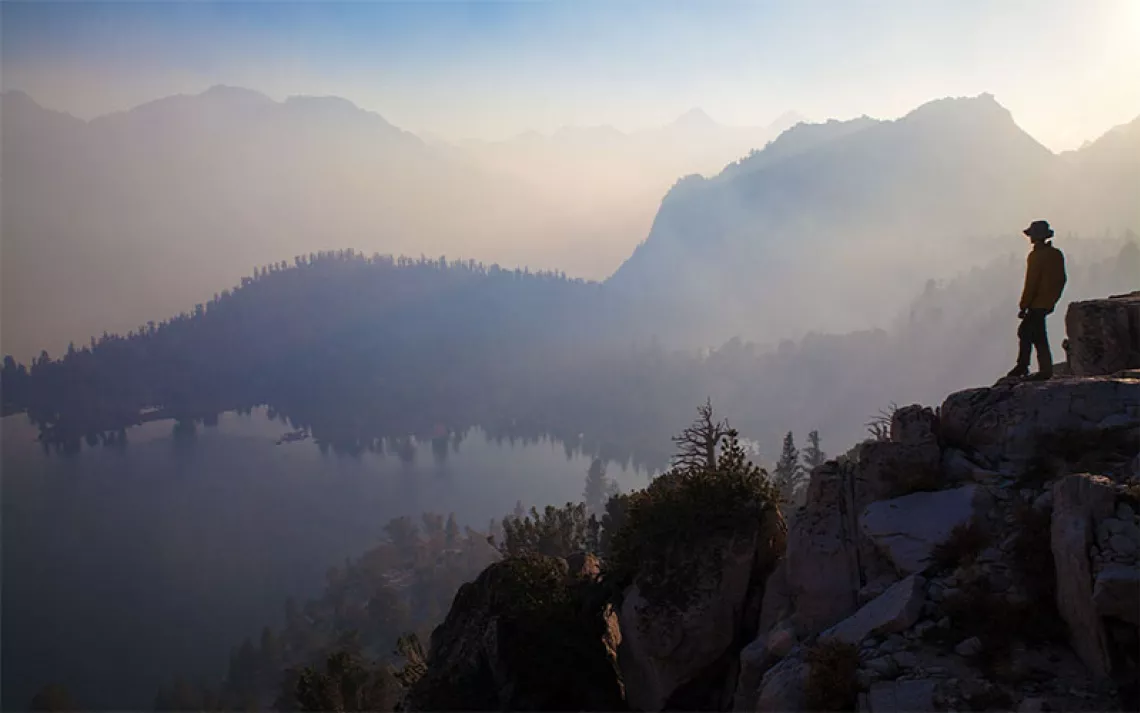At Yosemite National Park, the Crush of Visitors Sparks a Construction Boom
As more concrete is poured in the national park, other ways of managing visitation are being explored

Construction in Yosemite Valley. | Photo by Craig Kohlruss
At Yosemite National Park, birdsong and the roar of iconic waterfalls in Yosemite Valley have been replaced in some places by the racket of heavy machinery.
At Bridalveil Fall, backhoes have dug trenches that construction workers then filled with rebar and concrete to construct new viewing platforms. Workers there also sliced into a large boulder, brought in long metal beams to build an additional trail, cut down trees to make way for parking spaces, and installed a new sewer system.
The construction at Bridalveil Fall—which Yosemite Conservancy describes as “restoration”—is among a slew of projects that have taken place during the past few years at the world-famous park in California. The work has been so intensive and widespread that, during one meeting last year with area businesses and nonprofits, Yosemite’s superintendent joked that visitors should bring their hard hats for a “crazy construction season in Yosemite like we’ve never seen before.”
The construction frenzy is not amusing to some environmentalists, who don’t see more development as a solution to overcrowding. The construction boom has brought a new focus to Yosemite’s always challenging balancing act between conservation and the crush of millions of annual visitors.
“The visitors come here to experience the wilderness aspect of Yosemite National Park and the beauty of the way it used to be, and it’s turning into more parking lots, more trees being taken down, more native plants being taken out,” said Vernett “Sis” Calhoun, chairperson of the Wahhoga Committee that is resurrecting Yosemite’s last Native American village. Bill Tucker, a Paiute and Shoshone elder who lived in that village before it was destroyed, has similar feelings. He nicknamed construction around Bridalveil Fall “cement city.”
Current and recent construction projects by the National Park Service in Yosemite include new and expanded parking lots; additional large flush bathroom facilities and sewer lines; more paved trails and plazas; another Yosemite Valley visitor center; a $31 million renovation of the Ahwahnee hotel; felling trees to improve views; paving roads and reconfiguring traffic flows; upgrading wastewater treatment plants; redoing and adding power lines; and remodeling campgrounds and adding campsites, including at Camp 4, the celebrated home base for El Capitan climbers. The Park Service also wants to build a new Tuolumne Meadows visitor center and develop an RV campground just outside the park, where Yosemite leaders ousted mobile home owners last year on a rapid timeline without compensation.
A flush bathroom under construction beneath Bridalveil Fall threatens to degrade water quality in an area that had been relatively undeveloped by Yosemite Valley standards. The site used to have simple pit toilets. Adding flush toilets at the waterfall required installing new sewer lines that now snake past Fern Spring and through a bridge over the Merced River. Greg Adair, former director of the now-inactive Friends of Yosemite Valley, remembers how the Park Service temporarily dewatered a section of the Merced River years ago to install another sewer line as the most dramatic example of the impacts these projects can have on the environment.
Years of litigation brought by Adair’s group culminated in a 2014 Merced River plan. That plan has been used to justify much of the recent development—including projects not mentioned in the plan. “In Yosemite Valley, they should have written an honest plan to build nothing further,” Adair said. “If they were going to build anything, it would have to be at most a one-to-one exchange for something they’ve already got.”
Park officials maintain that the construction is needed to accommodate visitors. Annual Yosemite visitation reached a high of over 5 million people in 2016. That dropped to between 2 and 3 million a year when the park put a reservation system in place during the height of the pandemic. A looser reservation system returned last year because of the heavy construction. Bigger crowds are expected this spring and summer since reservations aren’t required to enter the park for the first time in several years.
“When you got a whole shopping center and all this stuff, it’s too late for Yosemite Valley,” said Alan Carlton, chair of Sierra Club’s Yosemite Committee. During his most recent trip to the park last fall, the Bay Area resident skipped the valley and headed straight to its high country.
But development is also increasing in the park’s less visited areas. At Tuolumne Meadows, the Park Service bulldozed old trees to make way for new parking lots designed to stop roadside parking. At Tenaya Lake, sidewalks along Tioga Road added a new concrete strip to an alpine lakeshore.
Working for the Park Service as a Native American monitor on construction projects, Ronda Kauk, a Mono Lake Paiute woman of the Kutzadika’a tribe, witnessed many trees being torn down to make way for development. The sight made her feel sad, sick, and overwhelmed. “If our bodies were the Earth, how many times would you want to be operated on?” Kauk asked.
Park officials don’t like to think of the new lots as additional parking, but instead as just a way to move existing traffic off the roadside. “The whole goal is to make it a much better experience for everybody,” Kathleen Morse, Yosemite’s chief of strategic planning and project management, told me when I worked as a reporter for The Fresno Bee.
Morse acknowledged that construction is also hard for her to witness but “you have to make an impact to have an impact.” An interdisciplinary team ensures that “we’ve got our bases covered and taken care of what’s important,” Morse also said during that late 2021 interview about construction in Yosemite. She also noted conservation efforts like restoring meadows and riverbanks in addition to the more construction-heavy projects. When she and Yosemite spokesman Scott Gediman were contacted for this story, Gediman said park officials didn’t have new information to share.
Some current Park Service projects even involve commercial logging, said Chad Hanson, director and cofounder of the John Muir Project, which sued Yosemite last summer over its tree chopping. “The common denominator in all of these development projects,” Hanson said, “including the logging that we’re challenging right now in court, is that they’re saying that they can tier to these old, outdated management plans without doing any new public notice, comment, or environmental analysis.” (Hanson is also a member of the Sierra Club Board of Directors; the Sierra Club is not a party to his organization’s lawsuit.)
In the midst of all this construction, a number of environmental groups say it’s time for Yosemite to implement a permanent reservation system, as has happened at some other parks. Yosemite is “too precious to allow a return to an unregulated visitation policy and all the negative effects that result,” reads one letter sent to the park over a year ago, signed by Carlton of the Sierra Club and leaders from a handful of other conservation groups.
Mark Rose, Sierra Nevada program manager for the National Parks Conservation Association, said a permanent reservation system during peak visitation times of the year is critical for Yosemite to abide by the Park Service’s mission of managing public lands in a manner that will “leave them unimpaired for the enjoyment of future generations.”
“Yosemite must put the protection of park resources above that of unfettered access in order to effectively manage visitation in the park,” Rose wrote in a letter he submitted to the park earlier this year.
Yosemite officials say they are considering a reservation system as an option. Park officials are developing a Visitor Access Management Plan that will evaluate reservation systems and other management strategies. The first public comment period for that plan closed in early February. Park officials said they will seek more feedback about it this summer.
Equitable access to the national park is among the concerns with a reservation system. Rose said the process of obtaining reservations and permits via recreation.gov should be improved since the system currently creates “huge hurdles” for visitors with limited computer or internet access, or who are not native English speakers.
“Whether it be barriers in language, transportation, cost, or overall messaging and awareness, low-income individuals and persons of color are far less likely to visit the park than older, higher income, white individuals,” Rose said about the importance of simultaneously working to bolster access for those groups. “This reality is especially concerning given the demographic makeup of communities in the Central Valley adjacent to the park, where many residents have never had a chance to visit the park despite living in close proximity to it.”
Yosemite Conservancy, the park’s principal philanthropic partner, isn’t taking an official position about reservations. The conservancy’s president, Frank Dean, said: “Regarding Yosemite traffic and crowding, it seems more appropriate to manage to a solution rather than build satellite parking lots.” The conservancy has given the park more than $152 million in grants to fund more than 800 projects and programs over the past two decades. Some projects removed asphalt, like at Yosemite’s Mariposa Grove of Giant Sequoias, but added it elsewhere. Trade-offs at the big trees included building a new parking lot for disabled access near the Grizzly Giant and covering dirt paths around that famous tree with a more natural pavement.
Enock Glidden, a trail accessibility specialist and rock climber who is paraplegic, said major destinations should be made accessible to all if the location warrants it—but that doesn’t have to be done by paving. Options include dirt stabilizers to make the ground firmer, rerouting around obstacles, and making switchbacks and boardwalks, said Glidden, who added that there’s “amazingly accessible” pit toilets too.
The challenge of striking a balance between conservation and the needs and desires of visitors is also at play at Yosemite’s Wahhoga village, which will feature Indigenous dwellings such as a traditional roundhouse built with natural materials. Park officials also hope to install utilities in the village so that a small health and safety building with flush toilets can be added later. Calhoun is opposed to paving trails in the village, however. She wants more natural paths and said she is “really excited about having our native plants in the area.”
All these changes add up. Hanson worries about development and resource extraction that he calls completely unprecedented for Yosemite or any national park.
“As Yosemite goes, so too do all the other parks,” Hanson said. “If it can happen in Yosemite, it can happen anywhere.”
 The Magazine of The Sierra Club
The Magazine of The Sierra Club



